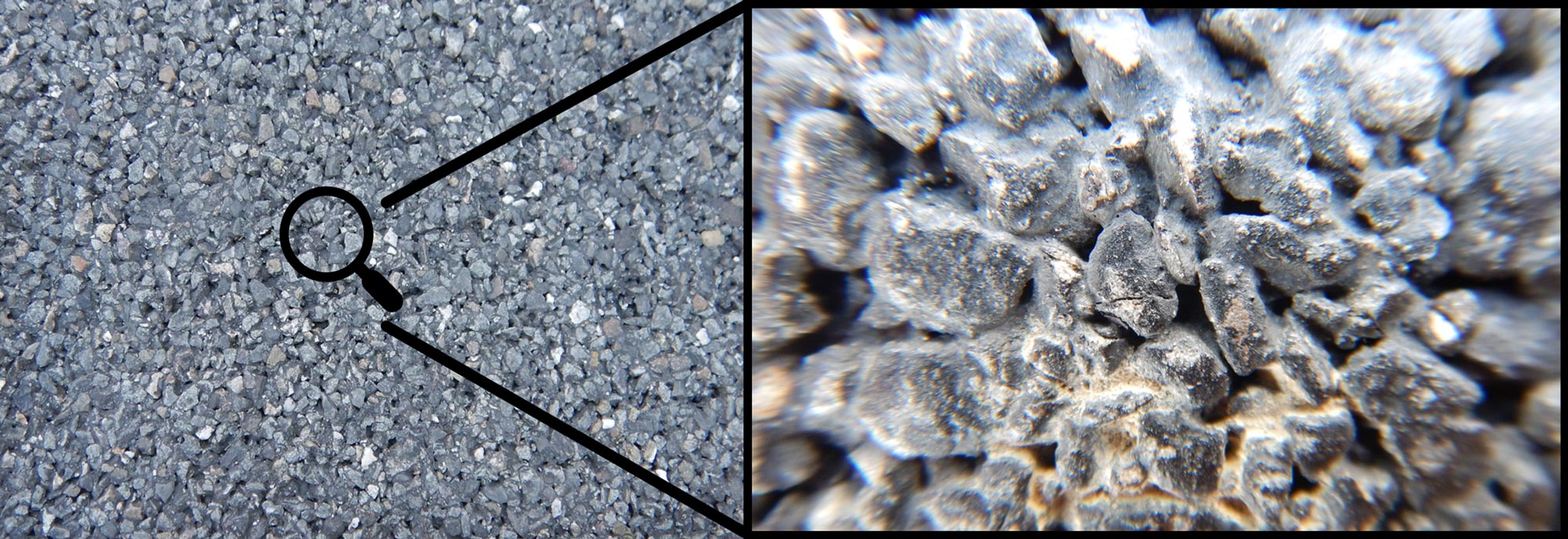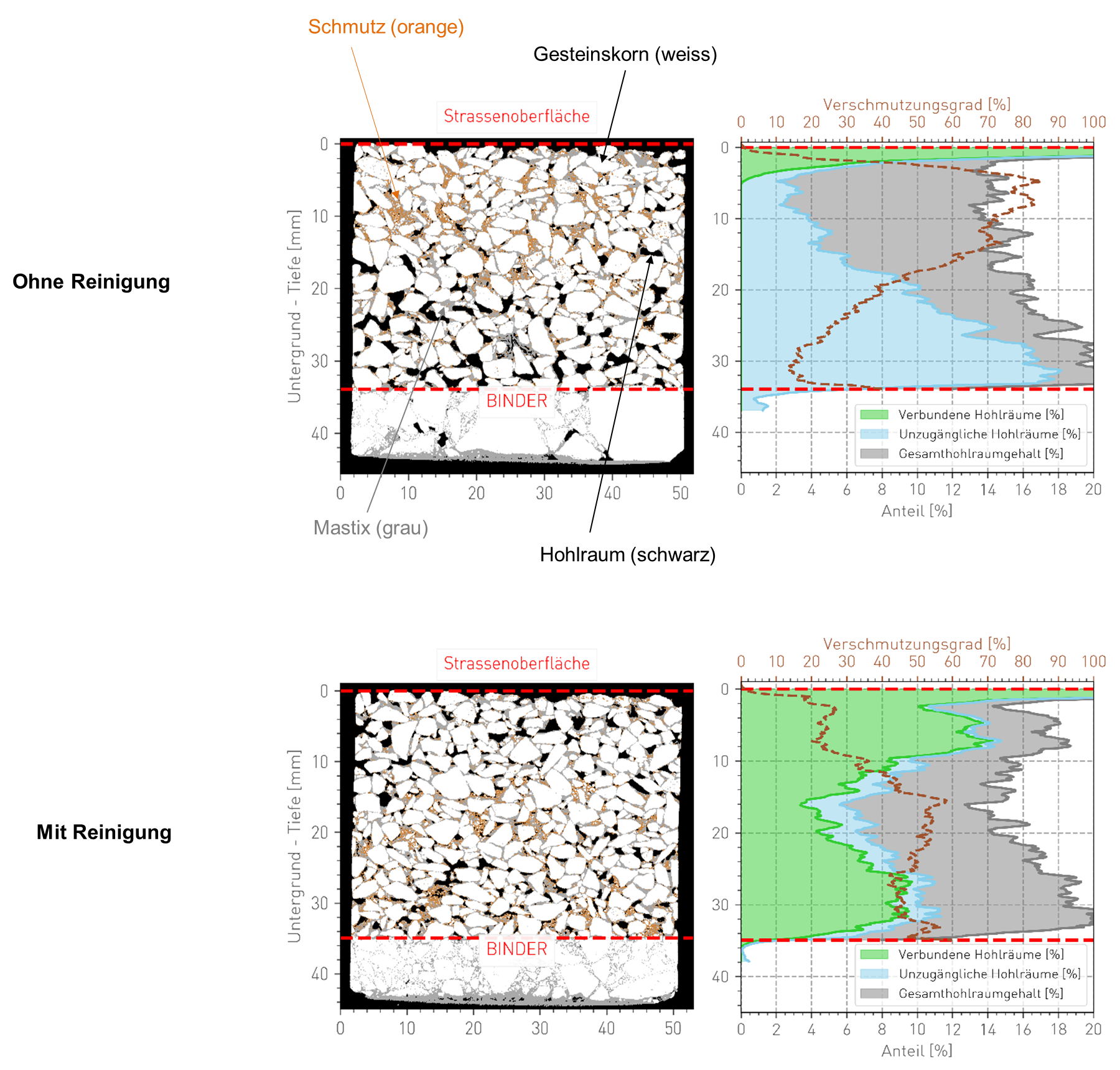More silence in Switzerland thanks to over 1,000 low-noise road surfaces
Low-noise road surfaces (LAB), also known as "whisper road surfaces ", can significantly reduce road noise and thus make an important contribution to people and the environment. Compared to conventional road surfaces , low-noise road surfaces have a higher void content and a finer surface texture. A low-noise road surfaces is therefore not a closed body, but has a porous structure. This pore structure absorbs sound waves, ventilates and thus reduces the rolling noise of tires. Already, more than 1,000 low-noise road surfaces of the latest generation are ensuring greater peace and quiet in Swiss towns and villages. The trend is strongly increasing.
Less dirt means better noise reduction
G+P has carried out over 2500 measurements on low-noise road road surfaces, which show that the measures are effective. However, the initially very impressive noise reduction decreases with increasing service life. This is due, on the one hand, to the fact that the pores, which are so important for sound absorption, become increasingly clogged by the ingress of dirt and, on the other hand, because the surface becomes rougher due to grain breakouts. Both developments significantly reduce the acoustic performance. One possible measure to counteract this drop in performance is preventive, regular cleaning of the road surfaces. However, the mode of action and the actual effects of such preventive cleaning measures had hardly been investigated so far, which is why G+P's Research & Development department tackled this issue.

Where is the dirt and how can it be removed? - a challenging question for our research and development department!
If you want to remove the dirt effectively, you first have to know where exactly it is in the whispering floor. Conclusion of the team: We need new analysis tools to locate the dirt exactly and to measure the effectiveness and possible negative effects of preventive cleaning measures. The following analysis tools were then developed by our R&D team:
- Looking inside the pavement: The team is developing the Acoustic Void Content Analysis AVCA tool, which can be used to precisely locate dirt in the 3D model (CT scan) of the whispering pavement and determine its impact on the effective pore structure and acoustics.
- Exclude damage: G+P's R&D team is developing a 3D analysis method for inspecting the surface of the whispering pavement with extremely high resolution. Regular cleaning processes could damage the asphalt. Thanks to the developed 3D inspection, the smallest changes in the surface texture can be identified at an early stage.
- Capture additional pavement parameters: Water permeability measurements on the pavement can be used to further investigate the accessibility of the pores near the surface. The measurement method used here was developed by G+P specifically for road surfaces and optimized accordingly.
G+P with new insights!
The CPX noise level measurements over several years show an average noise reduction of 1.7 dB for the cleaned section compared to the uncleaned reference section at a study site. The cleaning measures thus have a positive effect on the acoustic performance and service life of the pavement.
The AVCA method specially developed by G+P for evaluating cores also clearly shows in Figure 2 why the acoustic performance of cleaned sections is maintained in contrast to uncleaned sections: The majority of the pores are free of dirt in the first 10 to 20 mm after cleaning - in contrast to the pores of the uncleaned reference section, which are clogged with dirt. The pores or voids unchanged by the cleaning can absorb the rolling noise as usual and continue to ensure the desired noise reduction.

Figure: Cross-section profiles (CT scans) and corresponding AVCA evaluation of two cores of an investigation site. In the uncleaned section, the voids in the first approx. 20 mm are heavily contaminated (brown line), consequently the pore volumes are mostly closed. In the cleaned section, the degree of contamination in the uppermost layer is significantly lower and the majority of the existing cavities are interconnected (green area).
The results of the texture measurements also show that proper cleaning does not lead to more grain breakouts and that the pavement surface is thus not additionally damaged by the cleaning measures.
Conclusion: Extended service life of whispering road surfaces thanks to scientifically based investigation of cleaning measures
Based on several studies in cooperation with the cantons and the federal authorities, G+P can now scientifically prove that preventive cleaning of low-noise road surfaces can positively influence their acoustic service life. In addition, the AVCA method developed by G+P can clearly demonstrate that and to what extent the pore volumes can be kept free by regular cleaning measures.
Thanks to the new analysis tools, dirt in whispering road surfaces can now be clearly identified for the first time. These new findings enable cleaning procedures to be continuously optimized and used effectively. G+P will continue to work on this exciting issue of dirt in whispering road surfaces in the future and thus make an important contribution to people and the environment.
/www.gundp.ch/file/1803/Querschnitt_Fl%C3%BCsterbelag_SDA.jpg)
/www.gundp.ch/file/2370/Titelbild_LAB_LCA_v4.png)
/www.gundp.ch/file/2523/Blog_Vorschaubild_Weibel-AG.png)
/www.gundp.ch/file/2967/analyse-road-conditions-with-your-smartphone.png)